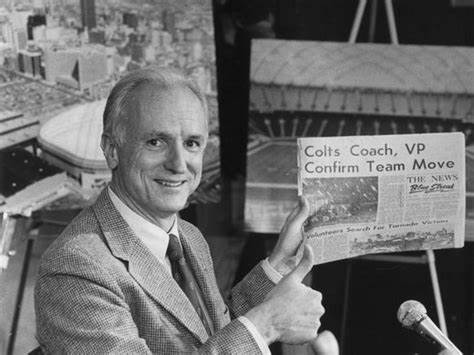This Day In History
1984 Baltimore Colts move to Indianapolis

On this day in 1984, Bob Irsay (1923-1997), owner of the once-mighty Baltimore Colts, moves the team to Indianapolis. Without any sort of public announcement, Irsay hired movers to pack up the team’s offices in Owings Mills, Maryland, in the middle of the night, while the city of Baltimore slept.
Robert Irsay gained control of the Colts in 1972 when he essentially traded his ownership in the Los Angeles Rams with Carol Rosenbloom, then the owner of the Colts franchise. The Colts, led by quarterback Johnny Unitas, halfback Lenny Moore and defensive linemen Gino Marchetti and Art Donovan, had been the best team in the NFL in the late 1950s and had come to embody the working class spirit of Baltimore. The players lived among the fans, worked alongside the fans in the off-season and performed with evident pride in their adopted city. It wasn’t until Irsay purchased the team that the franchise began its downward spiral. After winning Super Bowl V in 1971, the Colts had a few winning years, but by the late 1970s, the franchise was so bad that when future Hall of Fame quarterback John Elway was drafted number one overall by the Colts out of Stanford in 1983, he refused to report to the team, saying he would play baseball for the New York Yankees instead. The Colts were forced to trade Elway to the Denver Broncos.
To make matters worse for the Colts, Irsay was by most accounts a difficult boss–he was infamous for his temper and was known to angrily lash out at players and employees. In 1984, Irsay asked the city of Baltimore to pay for improvements to Memorial Stadium, where the Colts played. But, here again, his irascibility may have gotten in the way. Although the two sides told different stories of what went on in the negotiations, it did not go well by any account, and on March 28, the Maryland state legislature passed a law allowing they city of Baltimore to seize the Colts from Irsay. Rather than give up his team, Irsay quickly took a deal offered by the city of Indianapolis and moved the Colts before anyone knew what had happened. Baltimore fans were stunned, and the Colts marching band, long a fixture at games, defiantly continued to perform in the city.
Football did not return to the Charm City until 1996, when Cleveland Browns owner Art Modell (1925-2012 ), in a dispute with the city of Cleveland over the stadium the Browns played in, agreed to move the Browns to Baltimore in return for a brand-new stadium built with taxpayer money. Although the Browns had enjoyed many years of success and rabid fan support while in Cleveland, Modell claimed that financial hardship forced his hand. The Browns were renamed the Baltimore Ravens after the poem “The Raven,” penned by Baltimore native Edgar Allen Poe. Under the leadership of General Manager Ozzie Newsome, a Browns Hall of Famer, the franchise has seen consistent success in Baltimore, including victory in Super Bowl XXXV in 2001, with many players that had actually been drafted as Browns. Art Modell, however, is now as reviled a man in Cleveland as Bob Irsay was in Baltimore. He sold controlling interest in the team in 2003.
Source: www.history.com
This Day In History
Truman announces development of H-bomb

U.S. President Harry S. Truman publicly announces his decision to support the development of the hydrogen bomb, a weapon theorized to be hundreds of times more powerful than the atomic bombs dropped on Japan during World War II.
Five months earlier, the United States had lost its nuclear supremacy when the Soviet Union successfully detonated an atomic bomb at their test site in Kazakhstan. Then, several weeks after that, British and U.S. intelligence came to the staggering conclusion that German-born Klaus Fuchs, a top-ranking scientist in the U.S. nuclear program, was a spy for the Soviet Union. These two events, and the fact that the Soviets now knew everything that the Americans did about how to build a hydrogen bomb, led Truman to approve massive funding for the superpower race to complete the world’s first “superbomb,” as he described it in his public announcement on January 31.
On November 1, 1952, the United States successfully detonated “Mike,” the world’s first hydrogen bomb, on the Eniwetok Atoll in the Pacific Marshall Islands. The 10.4-megaton thermonuclear device, built upon the Teller-Ulam principles of staged radiation implosion, instantly vaporized an entire island and left behind a crater more than a mile wide. The incredible explosive force of Mike was also apparent from the sheer magnitude of its mushroom cloud–within 90 seconds the mushroom cloud climbed to 57,000 feet and entered the stratosphere. One minute later, it reached 108,000 feet, eventually stabilizing at a ceiling of 120,000 feet. Half an hour after the test, the mushroom stretched 60 miles across, with the base of the head joining the stem at 45,000 feet.
Three years later, on November 22, 1955, the Soviet Union detonated its first hydrogen bomb on the same principle of radiation implosion. Both superpowers were now in possession of the “hell bomb,” as it was known by many Americans, and the world lived under the threat of thermonuclear war for the first time in history.
Source: https://www.history.com/this-day-in-history/truman-announces-development-of-h-bomb
This Day In History
Gandhi assassinated

Mohandas Karamchand Gandhi, the political and spiritual leader of the Indian independence movement, is assassinated in New Delhi by a Hindu extremist.
Born the son of an Indian official in 1869, Gandhi’s Vaishnava mother was deeply religious and early on exposed her son to Jainism, a morally rigorous Indian religion that advocated nonviolence. Gandhi was an unremarkable student but in 1888 was given an opportunity to study law in England. In 1891, he returned to India, but failing to find regular legal work he accepted in 1893 a one-year contract in South Africa.
Settling in Natal, he was subjected to racism and South African laws that restricted the rights of Indian laborers. Gandhi later recalled one such incident, in which he was removed from a first-class railway compartment and thrown off a train, as his moment of truth. From thereon, he decided to fight injustice and defend his rights as an Indian and a man. When his contract expired, he spontaneously decided to remain in South Africa and launched a campaign against legislation that would deprive Indians of the right to vote. He formed the Natal Indian Congress and drew international attention to the plight of Indians in South Africa. In 1906, the Transvaal government sought to further restrict the rights of Indians, and Gandhi organized his first campaign of satyagraha, or mass civil disobedience. After seven years of protest, he negotiated a compromise agreement with the South African government.
In 1914, Gandhi returned to India and lived a life of abstinence and spirituality on the periphery of Indian politics. He supported Britain in the First World War but in 1919 launched a new satyagraha in protest of Britain’s mandatory military draft of Indians. Hundreds of thousands answered his call to protest, and by 1920 he was leader of the Indian movement for independence. He reorganized the Indian National Congress as a political force and launched a massive boycott of British goods, services, and institutions in India. Then, in 1922, he abruptly called off the satyagraha when violence erupted. One month later, he was arrested by the British authorities for sedition, found guilty, and imprisoned.
Source: https://www.history.com/this-day-in-history/gandhi-assassinated
This Day In History
U.S. Baseball Hall of Fame elects first members

On January 29, 1936, the U.S. Baseball Hall of Fame elects its first members in Cooperstown, New York: Ty Cobb, Babe Ruth, Honus Wagner, Christy Matthewson and Walter Johnson.
The Hall of Fame actually had its beginnings in 1935, when plans were made to build a museum devoted to baseball and its 100-year history. A private organization based in Cooperstown called the Clark Foundation thought that establishing the Baseball Hall of Fame in their city would help to reinvigorate the area’s Depression-ravaged economy by attracting tourists. To help sell the idea, the foundation advanced the idea that U.S. Civil War hero Abner Doubleday invented baseball in Cooperstown. The story proved to be phony, but baseball officials, eager to capitalize on the marketing and publicity potential of a museum to honor the game’s greats, gave their support to the project anyway.
In preparation for the dedication of the Hall of Fame in 1939—thought by many to be the centennial of baseball—the Baseball Writers’ Association of America chose the five greatest superstars of the game as the first class to be inducted: Ty Cobb was the most productive hitter in history; Babe Ruth was both an ace pitcher and the greatest home-run hitter to play the game; Honus Wagner was a versatile star shortstop and batting champion; Christy Matthewson had more wins than any pitcher in National League history; and Walter Johnson was considered one of the most powerful pitchers to ever have taken the mound.
Today, with approximately 350,000 visitors per year, the Hall of Fame continues to be the hub of all things baseball.
Source: https://www.history.com/this-day-in-history/u-s-baseball-hall-of-fame-elects-first-members
-

 NEWS2 years ago
NEWS2 years ago2 hurt, 1 jailed after shooting incident north of Nocona
-

 NEWS1 year ago
NEWS1 year agoSuspect indicted, jailed in Tia Hutson murder
-

 NEWS2 years ago
NEWS2 years agoSO investigating possible murder/suicide
-

 NEWS2 years ago
NEWS2 years agoWreck takes the life of BHS teen, 16
-

 NEWS2 years ago
NEWS2 years agoMurder unsolved – 1 year later Tia Hutson’s family angry, frustrated with no arrest
-

 NEWS2 years ago
NEWS2 years agoSheriff’s office called out to infant’s death
-

 NEWS2 years ago
NEWS2 years agoBowie Police face three-hour standoff after possible domestic fight
-

 NEWS2 years ago
NEWS2 years agoDriver stopped by a man running into the street, robbed at knifepoint







